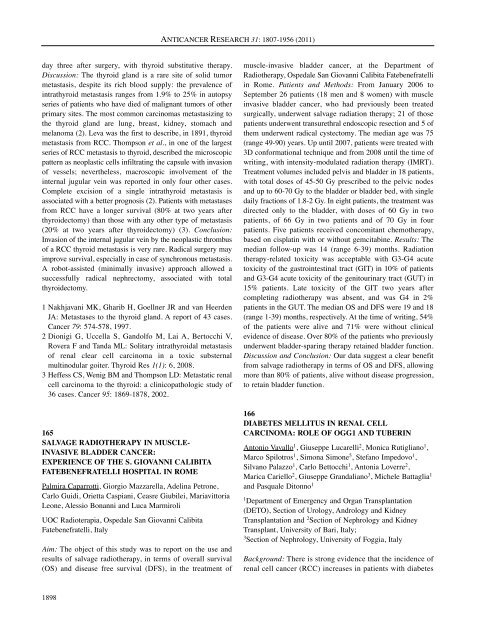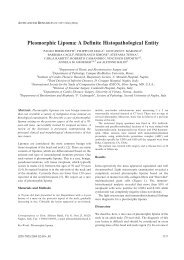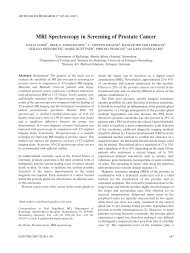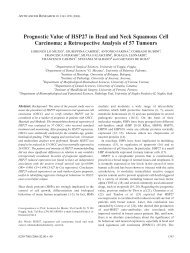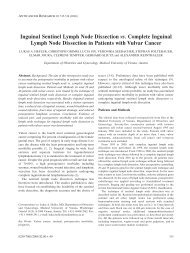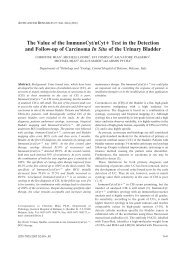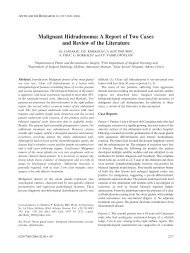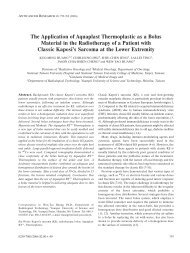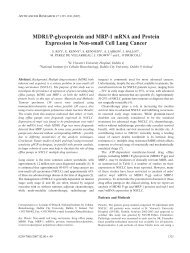ABSTRACTS OF THE 21st ANNUAL MEETING OF THE ITALIAN ...
ABSTRACTS OF THE 21st ANNUAL MEETING OF THE ITALIAN ...
ABSTRACTS OF THE 21st ANNUAL MEETING OF THE ITALIAN ...
Create successful ePaper yourself
Turn your PDF publications into a flip-book with our unique Google optimized e-Paper software.
day three after surgery, with thyroid substitutive therapy.<br />
Discussion: The thyroid gland is a rare site of solid tumor<br />
metastasis, despite its rich blood supply: the prevalence of<br />
intrathyroid metastasis ranges from 1.9% to 25% in autopsy<br />
series of patients who have died of malignant tumors of other<br />
primary sites. The most common carcinomas metastasizing to<br />
the thyroid gland are lung, breast, kidney, stomach and<br />
melanoma (2). Leva was the first to describe, in 1891, thyroid<br />
metastasis from RCC. Thompson et al., in one of the largest<br />
series of RCC metastasis to thyroid, described the microscopic<br />
pattern as neoplastic cells infiltrating the capsule with invasion<br />
of vessels; nevertheless, macroscopic involvement of the<br />
internal jugular vein was reported in only four other cases.<br />
Complete excision of a single intrathyroid metastasis is<br />
associated with a better prognosis (2). Patients with metastases<br />
from RCC have a longer survival (80% at two years after<br />
thyroidectomy) than those with any other type of metastasis<br />
(20% at two years after thyroidectomy) (3). Conclusion:<br />
Invasion of the internal jugular vein by the neoplastic thrombus<br />
of a RCC thyroid metastasis is very rare. Radical surgery may<br />
improve survival, especially in case of synchronous metastasis.<br />
A robot-assisted (minimally invasive) approach allowed a<br />
successfully radical nephrectomy, associated with total<br />
thyroidectomy.<br />
1 Nakhjavani MK, Gharib H, Goellner JR and van Heerden<br />
JA: Metastases to the thyroid gland. A report of 43 cases.<br />
Cancer 79: 574-578, 1997.<br />
2 Dionigi G, Uccella S, Gandolfo M, Lai A, Bertocchi V,<br />
Rovera F and Tanda ML: Solitary intrathyroidal metastasis<br />
of renal clear cell carcinoma in a toxic substernal<br />
multinodular goiter. Thyroid Res 1(1): 6, 2008.<br />
3 Heffess CS, Wenig BM and Thompson LD: Metastatic renal<br />
cell carcinoma to the thyroid: a clinicopathologic study of<br />
36 cases. Cancer 95: 1869-1878, 2002.<br />
165<br />
SALVAGE RADIO<strong>THE</strong>RAPY IN MUSCLE-<br />
INVASIVE BLADDER CANCER:<br />
EXPERIENCE <strong>OF</strong> <strong>THE</strong> S. GIOVANNI CALIBITA<br />
FATEBENEFRATELLI HOSPITAL IN ROME<br />
Palmira Caparrotti, Giorgio Mazzarella, Adelina Petrone,<br />
Carlo Guidi, Orietta Caspiani, Ceasre Giubilei, Mariavittoria<br />
Leone, Alessio Bonanni and Luca Marmiroli<br />
UOC Radioterapia, Ospedale San Giovanni Calibita<br />
Fatebenefratelli, Italy<br />
Aim: The object of this study was to report on the use and<br />
results of salvage radiotherapy, in terms of overall survival<br />
(OS) and disease free survival (DFS), in the treatment of<br />
1898<br />
ANTICANCER RESEARCH 31: 1807-1956 (2011)<br />
muscle-invasive bladder cancer, at the Department of<br />
Radiotherapy, Ospedale San Giovanni Calibita Fatebenefratelli<br />
in Rome. Patients and Methods: From January 2006 to<br />
September 26 patients (18 men and 8 women) with muscle<br />
invasive bladder cancer, who had previously been treated<br />
surgically, underwent salvage radiation therapy; 21 of those<br />
patients underwent transurethral endoscopic resection and 5 of<br />
them underwent radical cystectomy. The median age was 75<br />
(range 49-90) years. Up until 2007, patients were treated with<br />
3D conformational technique and from 2008 until the time of<br />
writing, with intensity-modulated radiation therapy (IMRT).<br />
Treatment volumes included pelvis and bladder in 18 patients,<br />
with total doses of 45-50 Gy prescribed to the pelvic nodes<br />
and up to 60-70 Gy to the bladder or bladder bed, with single<br />
daily fractions of 1.8-2 Gy. In eight patients, the treatment was<br />
directed only to the bladder, with doses of 60 Gy in two<br />
patients, of 66 Gy in two patients and of 70 Gy in four<br />
patients. Five patients received concomitant chemotherapy,<br />
based on cisplatin with or without gemcitabine. Results: The<br />
median follow-up was 14 (range 6-39) months. Radiation<br />
therapy-related toxicity was acceptable with G3-G4 acute<br />
toxicity of the gastrointestinal tract (GIT) in 10% of patients<br />
and G3-G4 acute toxicity of the genitourinary tract (GUT) in<br />
15% patients. Late toxicity of the GIT two years after<br />
completing radiotherapy was absent, and was G4 in 2%<br />
patients in the GUT. The median OS and DFS were 19 and 18<br />
(range 1-39) months, respectively. At the time of writing, 54%<br />
of the patients were alive and 71% were without clinical<br />
evidence of disease. Over 80% of the patients who previously<br />
underwent bladder-sparing therapy retained bladder function.<br />
Discussion and Conclusion: Our data suggest a clear benefit<br />
from salvage radiotherapy in terms of OS and DFS, allowing<br />
more than 80% of patients, alive without disease progression,<br />
to retain bladder function.<br />
166<br />
DIABETES MELLITUS IN RENAL CELL<br />
CARCINOMA: ROLE <strong>OF</strong> OGG1 AND TUBERIN<br />
Antonio Vavallo1 , Giuseppe Lucarelli2 , Monica Rutigliano1 ,<br />
Marco Spilotros1 , Simona Simone5 , Stefano Impedovo1 ,<br />
Silvano Palazzo1 , Carlo Bettocchi1 , Antonia Loverre2 ,<br />
Marica Cariello2 , Giuseppe Grandaliano3 , Michele Battaglia1 and Pasquale Ditonno1 1Department of Emergency and Organ Transplantation<br />
(DETO), Section of Urology, Andrology and Kidney<br />
Transplantation and 2Section of Nephrology and Kidney<br />
Transplant, University of Bari, Italy;<br />
3Section of Nephrology, University of Foggia, Italy<br />
Background: There is strong evidence that the incidence of<br />
renal cell cancer (RCC) increases in patients with diabetes


